
Gastropteron chacmol
Gosliner, 1989
Order: CEPHALASPIDEA
Superfamily: PHILINOIDEA
Family: Gastropteridae
PHOTO
In 3-5 feet of water crawling on the sand during the day off Stocking Island, Exumas, Bahamas (Southern Bahamas) 5mm long alive. January 5, 2004. Photo: Anne DuPont
Animals reach 7mm in length and are active swimmers. The body colour is deep red to 'plum'. In some specimens yellow spots are scattered over the surface of the body. There is a bright yellow band at the parapodial edge. The anterior edge of the head shield is bilobed with a distinct median cleft. The siphon is simple as is typical for the genus. There is a pointed flagellum on the posterior part of the visceral hump. The gill is large, consisting of 7-10 plicate leaflets.
This species has been previously identified with the Mediterranean species Gastropteron rubrum by Abbott (1954, 1966) who reports it as 'moderately common' from Texas, Florida, West Indies to Brazil, and Marcus & Marcus (1960) who report it from Florida and Sao Paulo, Brazil and also note an earlier record from Guadeloupe. Gosliner adds new records from Yucatan Peninsula, Mexico and Caracas Is., Venezuela.
References:
• Abbott, R.T. (1954) American Seashells van Nostrand: New York. 541pp [and later editions]
• Gosliner, T.M. (1989): Revision of the Gastropteridae (Opisthobranchia: Cephalaspidea) with descriptions of a new genus and six new species. The Veliger, 32(4): 333-381.
• Marcus, Ev. & Marcus, Er. (1960)Opisthobranchs from American Atlantic warm waters. Bulletin of Marine Science of the Gulf and Caribbean, 10(2): 129-203.
Rudman, W.B., 2004 (January 17) Gastropteron chacmol Gosliner, 1989. [In] Sea Slug Forum. Australian Museum, Sydney. Available from http://www.seaslugforum.net/find/gastchac
Related messages
Gastropteron chacmol from San Andres, Colombia
January 21, 2006
From: Les Wilk
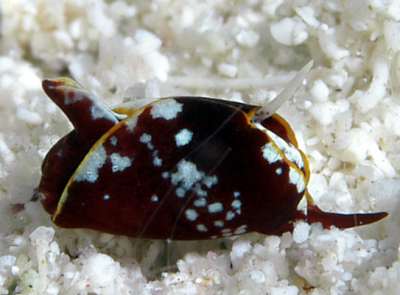
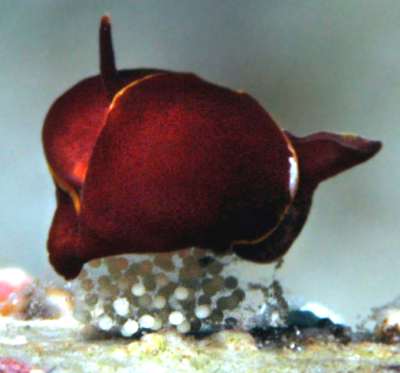
Hi Bill
Here are some photos of Gastropteron chacmol taken off the Colombian island of San Andres in the western Caribbean. One specimen with eggs, one without. They were abundant.
Locality: San Andres Island, Colombia. Caribbean. Depth: 15 feet. Length: less than 0.25 inch. August 2004. sandy bottom. Photographer: Keri Wilk
Les Wilk
wilk@reefnet.ca
Wilk, L., 2006 (Jan 21) Gastropteron chacmol from San Andres, Colombia. [Message in] Sea Slug Forum. Australian Museum, Sydney. Available from http://www.seaslugforum.net/find/15616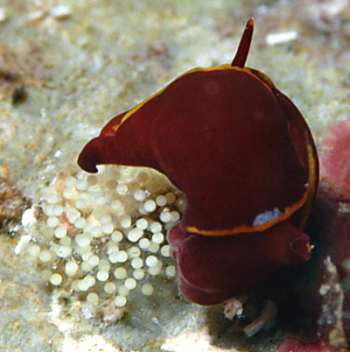
Thanks Les,
Terry Gosliner has reported it from Venezuela so this is a little further west. Thanks also to Keri for the wonderful photos of it laying its eggs.
Best wishes,
Bill Rudman
Re: Colour variation in Gastropteron chacmol
August 31, 2005
From: James Lyle
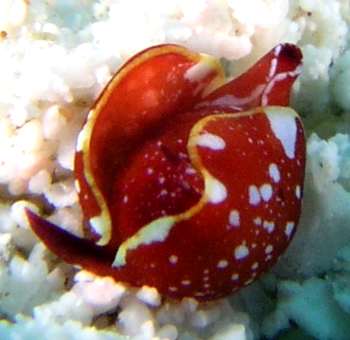
The range of the color variation for Gastropteron chacmol noted by Ann and Marina in earlier messages is now extended to Cozumel, Mexico. This image is the first Cozumel specimen that I have seen that looks like the color variation previously reported from the Bahamas. The tiny nudibranchs are quite common on the sand flats above the reefs and easy to find once you know what to look for.
Locality: Colombia Reef, Cozumel. Quintano Roo, Mexico, Caribbean. Depth: 15 metres. Length: 3 mm. 15 August 2005. sand flat. Photographer: Jim Lyle
Jim Lyle
jlyle@scubadiving.com
Lyle, J.L., 2005 (Aug 31) Re: Colour variation in Gastropteron chacmol. [Message in] Sea Slug Forum. Australian Museum, Sydney. Available from http://www.seaslugforum.net/find/14672Dear Jim,
This is a nice contrast to your earlier photo [#13184] of an unspotted animal.
Best wishes,
Bill Rudman
Gastropteron chacmol mating?
August 30, 2005
From: Anne DuPont
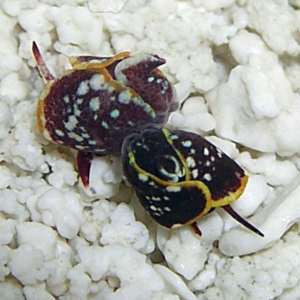
Bill,
Can you confirm that this is mating? These spotted Gastropteron chacmol were found on sand during the day. These were found with the larger black forms [message #14648 ], and smaller solid purple ones with a yellow border. They swam actively when disturbed. I found hundreds on the sand that afternoon.
Location: Sand Dollar Beach, Stocking Island, Exumas, Bahamas. Size: Approximately 5 mm each (see photograph on ruler. Depth: 3-6 feet of water. January 9, 2005
Cordially,
Anne DuPont
Delray Beach, FL
akdupont@bellsouth.net

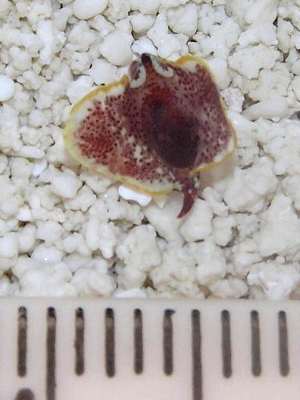
Dear Anne,
Thanks for these interesting photos. I have combined two [lower left] into a composite soI could display them together. It is nice to see the inside of the parapodia. It almost looks as though the dark red spots are on the inside surface. As to mating, I'm not sure. I have seen species of Siphopteron mating and they are like aglajids mating 'head to tail'. In cephalaspids the penis is on the right side of the head while the female opening is on the right side nearer the tail than the head so usually they don't mate right side to right side as in nudibranchs, because the parapodia are in the way. I also remember Bob Burn suggesting many years ago that in a species he looked at, the flagellum seemed to be involved in mating behaviour. My feeling is that this could be described as 'dating' rather than 'mating' but we still have a lot to learn about their biology.
Best wishes,
Bill Rudman
Re: Elysia from Belize?
February 21, 2005
From: Jim Lyle

Bill,
Concerning Julianne's message [#13182], I think it is Gastropteron chacmol. The G. chacmol that we have been finding in Cozumel, Mexico look exactly like Julianne's image shown in ambient light. It's only when you light them with a strobe that you can see that they are indeed red with a yellow margin.
Locality: Cozumel, Quintana Roo, Mexico, Caribbean. Depth: 10 meters, Length: 6 mm. 8 February 2005. on sand. Photographer: Jim Lyle.
Best,
Jim Lyle
jlyle@scubadiving.com
Lyle, J., 2005 (Feb 21) Re: Elysia from Belize?. [Message in] Sea Slug Forum. Australian Museum, Sydney. Available from http://www.seaslugforum.net/find/13184Dear Jim,
Thanks for sorting that out. If any one has photos of real Gastropteron vespertilium that I can add to the Forum I would be grateful.
Best wishes,
Bill Rudman
Elysia from Belize?
February 19, 2005
From: Julianne Parolisi
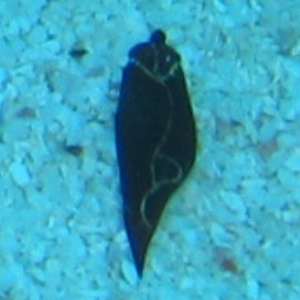
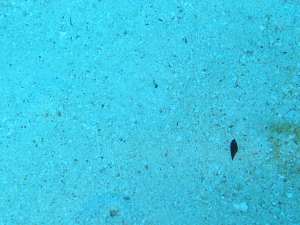
Hi Bill!
During a recent dive off Half Moon Cay in Belize, I spotted this tiny creature at ~30ft all alone in the middle of a huge expanse of sand.. The local divemaster I was with wasn't sure what was, saying only "it's our version of a spanish dancer" (??). It looked like some type of Elysia with it's mantle all wrapped up- any ideas? I know it's a horrible picture (didn't have a macro lens with me, and this guy was TINY!), but I thought I'd give it a shot.
Locality: Half Moon Cay, Belize, Caribbean Sea. Depth: ~ 30 ft. Length: ~1cm. 11 Feb 2005. sandy bottom near reef wall. Photographer: Julianne Parolisi
Thanks! :)
Julianne
aurorable@gmail.com
Parolisi, J., 2005 (Feb 19) Elysia from Belize?. [Message in] Sea Slug Forum. Australian Museum, Sydney. Available from http://www.seaslugforum.net/find/13182Note added 21 Feb 2005: See Jim Lyle's message [#13184] suggesting this is G. chacmol.
Dear Julianne,
It certainly is a little speck in the middle of an expanse of white sand. I have enlarged 'the speck' and your animal turns out to be quite an interesting find. Alhthough it has similarities in shape to an Elysia, the tube it has on its head shows that it is a member of the bubble-shell family Gastropteridae. I know of three species from the Caribbean region [see message #11964], and I am pretty sure your animal is Gastropteron vespertilium, which was described from Florida about 20 years ago and I don't think has been reported since then. That species is described as having a grayish or purplish black ground cover, with occasional blue grey spots on parapodia. There is a bright yellow [occasionally blue or green] line present on the edge of the parapodia and the siphon. The tentacle-like flagellum on the visceral hump is translucent white. Another Caribbean species, Gastropteron chacmol, is a reddish plum colour with a broader yellowish band around the parapodial edge.
Of course its difficult to be sure without a specimen, but it certainly looks like it.
Best wishes,
Bill Rudman
Colour variation in Gastropteron chacmol
March 4, 2004
From: Marina Poddubetskaia
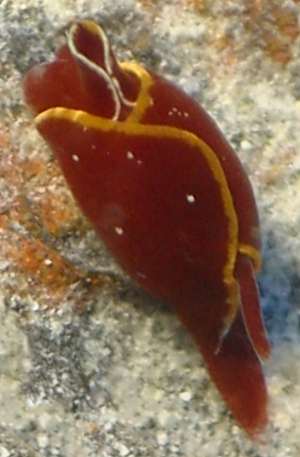
Dear Bill,
To complete the photos of Gastropteron chacmol on the Forum, here are some colour variations in this species. It is quite common near Anne DuPont's boat, in Exuma. All the specimens I saw there were found on the sand.
Upper right, Lower left:
Great Exuma, Bahamas, Western Atlantic. Site: Stocking Island, Hole n°2. Depth: 1m. February 01, 2004. Size: Upper right: 5mm, Lower left: 4mm.
: Lower right:
Location : Great Exuma, Bahamas, Western Atlantic. Site: Stocking Island, Hole n°2. Depth: 1m. February 02, 2004. Size: 7mm. Photos: Marina Poddubetskaia - Nembro website
Best wishes,
Marina (and Anne).
nembro@nembro.info
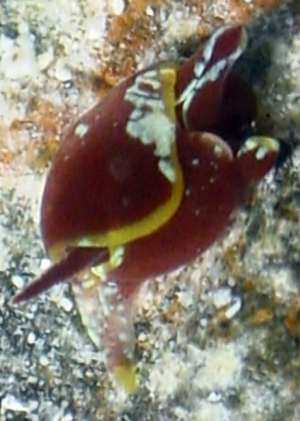
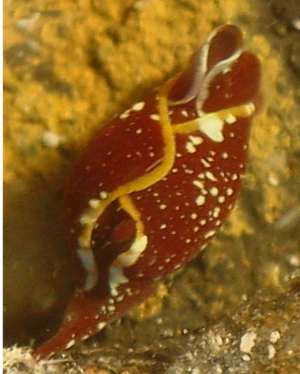
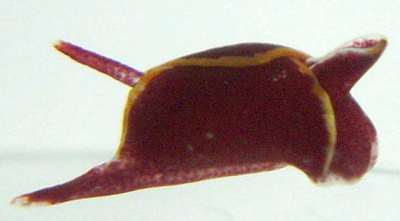
Thanks Marina & Anne,
Getting a record of colour variability is very useful. The side view I have included alonside is a nice link to Colin Redfern's photos [#11961]. If you look carefully you can see the individual pigment spots which match those in his photos.
Best wishes
Bill Rudman
Gastropteron chacmol from the Bahamas
January 20, 2004
From: Colin Redfern
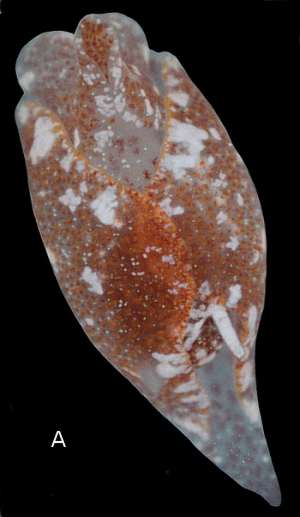
Dear Bill,
During the past couple of years I have occasionally collected examples of a species of Gastropteron from Abaco, Bahamas. All have patches of white, but some have many small spots of orange and purple-brown on the parapodia, with the flagellum almost completely white (A). On others (B & C) the color is mostly composed of much larger and less numerous purple spots, with purple and white spots on the flagellum.
I am grateful to Terry Gosliner for taking time to examine the anatomy of these animals, including the three specimens in the attached photos. He has informed me that the internal anatomy is entirely consistent with that of G. chacmol.
The Abaco material demonstrates a considerable variability in color for this species. On the other hand, Anne DuPont's animals from the Exumas appear very similar to the photographed specimens in Gosliner (1989, pl. 1I) which accompanied the description of G. chacmol.
Specimens in the attached photos were all dredged from areas of sand and scattered grass.
Photo A: 4mm. Lee side of Whale Cay, Abaco, Bahamas in 3m. August 20, 2002.
Photo B: 4.5mm. Lee side of Guana Cay, Abaco, Bahamas in 3.5m. August 19, 2002.
Photo C: 4mm. Lee side of Johnny's Cay, Abaco, Bahamas in 3.5m. August 22, 2003.
• Gosliner, T. M. 1989. Revision of the Gastropteridae (Opisthobranchia: Cephalaspidea) with descriptions of a new genus and six new species. The Veliger, 32(4): 333-381.
Best wishes,
Colin
bahamianseashells@att.net
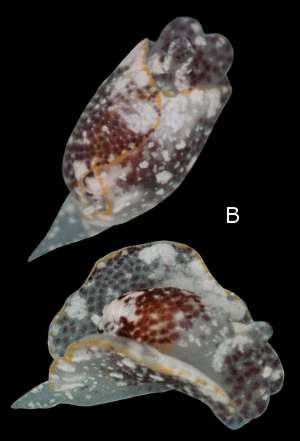

Thanks Colin,
As Terry Gosliner has reminded me Anne Dupont's animals are indeed almost identical to Terry's photo of G. chacmol in his original description. As Terry suggests, I suspect that all previous records of G. rubrum from the western Pacific for which there is colour information, are really G. chacmol. I am very interested in these animals of yours. If they do turn out to be G. chacmol it indeed cautions us from describing more new species of this group until we have a better idea of colour variation within existing species.
Best wishes
Bill Rudman
Gastropteron rubrum vs G. chacmol
January 20, 2004
From: Terry Gosliner
Dear Bill,
Anne DuPont's animal from the Bahamas is Gastropteron chacmol Gosliner, 1989. G. rubrum is a much larger animal and has major internal anatomical differences such as radula and penis. G. rubrum appears to be exclusively east Atlantic while G. chacmol is Caribbean.
Terry
tgosliner@CalAcademy.Org
Gosliner, T.M., 2004 (Jan 20) Gastropteron rubrum vs G. chacmol. [Message in] Sea Slug Forum. Australian Museum, Sydney. Available from http://www.seaslugforum.net/find/11963Thanks Terry,
I don't know how I forgot G. chacmol, especially since I have been referring to your 1989 paper concerning Siphopteron quadrispinosum. I am pleased to see that errors don't last long on the Forum.
Best wishes
Bill Rudman
Gastropteron from the west Atlantic
January 20, 2004
From: Bill Rudman
Following my forgetfulness over Gastropteron chacmol I have had a look for species of the family which have been described from the west Atlantic. Up until 1960, specimens were incorrectly identified as the east Atlantic species Gastropteron rubrum [see Marcus & Marcus, 1960]. I think I am correct in assuming that the since then 3 species have been recognised from the western Atlantic
• Gastropteron vespertilium Gosliner & Armes 1984. Ground colour grayish or purplish black with occasional blue grey spots on parapodia. A bright yellow [occasionally blue or green] line present on edge of parapodia and siphon. Flagellum translucent white. Known only from Tampa Bay, Florida.
• Gastropteron chacmol Gosliner 1989. Background colur to red to plum, with a bright yellow border to gills and siphon. Described from Yucatan Peninsula, Mexico but also known from Florida, Bahamas, Venezuela.
• Gastropteron hamanni Gosliner 1989 Uniformly yellow with a maroon apex to the siphon. Known from a single specimen, 4mm long. Turks & Caicos Ids
Two of these species. G. chacmol and G. vespertilium seem very similar in most respects. Both have a dark background colour deep red to plum in G. chacmol and grayish or purplish black in G. vespertilium, and both can have a yellow parapodial border. They both have yellow eggs and the only locality from which G. vespertilium has been reported falls within the distribution of G. chacmol. The anatomy of both species is very similar, the only difference I can see in the descriptions is that in G. chacmol the cerebral ganglia are close together while in G. vespertilium they are separated by a short commissure. I have no idea whether that difference is significant. As with some Indo-West Pacific species it would seem worthwhile to build up more information on colour variability within poplations of G. chacmol and G. vespertilium. If they are distinct species, and occur sympatrically [= in same geographic region], then its going to be important to find some way of distinguishing between them.
If anyone knows of other named species from the western Atlantic could they please let me know.
• Gosliner, T.M. & Armes, P.T. (1984) A new species of Gastropteron from Florida (Gastropoda: Opisthobranchia). The Veliger, 27(1): 54-64.
• Gosliner, T.M. (1989): Revision of the Gastropteridae (Opisthobranchia: Cephalaspidea) with descriptions of a new genus and six new species. The Veliger, 32(4): 333-381.
• Marcus, Ev. & Marcus, Er. (1960)Opisthobranchs from American Atlantic warm waters. Bulletin of Marine Science of the Gulf and Caribbean, 10(2): 129-203.
Best wishes
Bill Rudman
Gastropteron rubrum from the Bahamas
January 16, 2004
From: Anne DuPont

Note added 20 January 2004. This is Gastropteron chacmol. See message
Dear Bill,
Thank you for identifying the slugs last month from the Bahamas. This winter seems to be a very productive year for headshield slugs here in the Southern Bahamas
And I have found another one that I cannot identify. Can you identify it for me, please?
They were found on January 5, 2004 about 2:30 PM. They were in 3-5 feet of water crawling on the sand during the day off Stocking Island, Exumas, Bahamas (Southern Bahamas). They are very active little swimmers, and at the slightest movement swim around before settling back down on the sand. Their size was approximately 1/8 inch long. I saw approximately 100 on that dive. This is the same beach that I also found the Philinopsis aeci, Philinopsis depicta, Aglaja felis, Chelidonura hirundinina and Chelidonura berolina.
Thank you for your time.
Cordially,
Anne DuPont
Delray Beach, Fl USA
akdupont@bellsouth.net
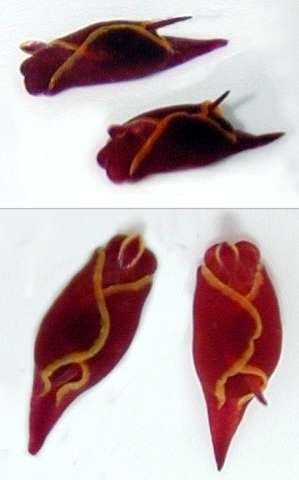
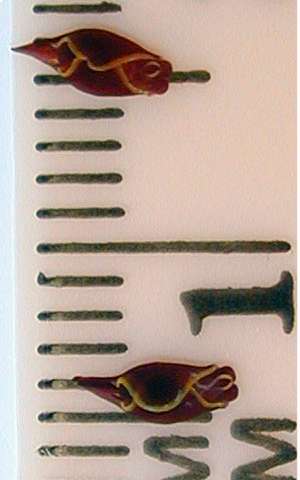
Dear Anne,
It may be a contradiction, but what are very abundant animals to you, are extremely rare to 'science' - which only shows how little we know. This is a species of Gastropteron, which is very timely as I am in the process of posting a number of messages about these animals from the western Pacific.
Your Gastropteron has been identified with the Mediterranean species Gastropteron rubrum by Abbott (1954, 1966) who reports it as 'moderately common' from Texas, Florida, West Indies to Brazil, and Marcus & Marcus (1960) report it from Florida and Sao Paulo, Brazil and also note an earlier record from Guadeloupe.
From the available information on the anatomy and colour variability of Gastropteron rubrum, I cannot say whether this is a correct identification for the Caribbean animals. It would certainly be useful to see more photos of this 'species' from both sides of the Atlantic. One other thing which would be nice to know is what thia animal eats. We don't know what any member of the family feeds on so if you have a large population to observe perhaps you could be lucky. Or perhaps you could try putting something tempting in front of one or two. My favourite guess would be a small flatworm.
• Abbott, R.T. (1954) American Seashells van Nostrand: New York. 541pp [and later editions]
• Marcus, Ev. & Marcus, Er. (1960)Opisthobranchs from American Atlantic warm waters. Bulletin of Marine Science of the Gulf and Caribbean, 10(2): 129-203.
Best wishes
Bill Rudman
